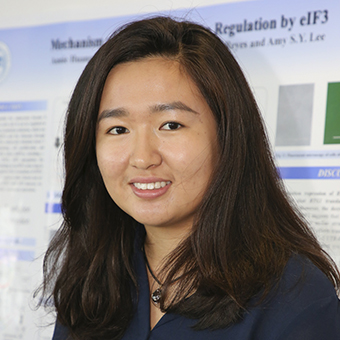Annie Huang
 Lee Laboratory
Lee Laboratory
Department of Biology
Brandeis University
The Mechanism of BTG1 Translation Repression by eIF3
Poster Abstract
All cells in our bodies contain the same DNA, but we are clearly made up of many different types of cells. This is due to, and is the result of gene regulation. Gene regulation is essential for eukaryotes because it determines what a particular cell can do by controlling when to express a certain gene. Gene expression can be regulated at many different stages including transcription of DNA to mRNA, as well as the translation of mRNAs to proteins. Translation is mostly controlled at the level of initiation, which involves the interactions between mRNA, initiation factor, and ribosome. Previous studies by Dr. Lee have shown that eukaryotic initiation factor 3 (eIF3) is responsible for regulating cell proliferation and differentiation by its interactions with two mRNAs that encode c-JUN and BTG1. The eIF3 complex upregulates the translation of c-JUN by directly binding to the c-JUN stem-loop structure and downregulates the translation of BTG1 in a different, as yet unidentified, mode. However, it is known that the translation inhibition is stem-loop specific, as reversing the stem-loop does not result in the repression of translation. To understand how mRNA and eIF3 interact, we seek to identify the co-factor. We plan on taking two approaches. The first one is to use mass spectrometry to identify the co-factor, assuming it interacts with the stem-loop and eIF3 through direct binding. The second approach is to incorporate Green Fluorescent Protein (GFP) into the sequence and use the CRISPR/Cas9 system to target and knockdown certain proteins. Screening will then be performed to isolate and identify the co-factor. By understanding the mechanism of eIF3 in gene regulation, we hope to understand more about cell growth control and possibly the link to cancer.
Personal Statement
My time working in Amy Lee’s research lab has been challenging, but rewarding. Dr. Lee is a new faculty member who established her laboratory in 2016-2017 and the lab was just a month old when I joined. The nascent lab has given me the chance to work closely with a small group of inspiring scientists and an enthusiastic mentor and the unique opportunity to learn more than just research. This experience has also demonstrated how one sets up and runs a lab.
Working full-time as a researcher, which is what I was able to do this summer as a Bauer Fellow, is a lot different from what I expected; it is more than just pipetting. Being a researcher is about problem solving, collaborating, thinking ahead, and the constant intake of new information. I am constantly challenged by unforeseen results. For instance, there was a day when I ran the same PCR four times and got completely different results each time. I never did figure out what went wrong, but sometimes that is science. Everything is about trial and error. Researching may not yield the most prolific results but this is what makes all the little discoveries so exciting and inspiring.